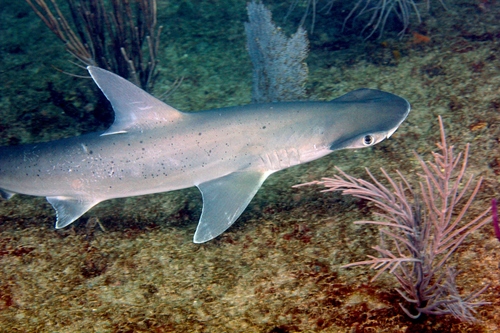
Bonnethead Shark
The Atlantic bluefin tuna (Thunnus thynnus) is a highly migratory, large pelagic fish renowned for its size, speed, and commercial value. It plays a crucial role in the marine ecosystem and has been a prized catch for centuries. Its unique physiology and life history make it a fascinating subject of study.
12 19 years
Lifespan
60 - 90 cm
Length
Least Concern
Conservation Status
40 km/h
Swimming speed
Carnivorous, Crustaceans
Diet
Seasonal Migration
Migration
Appearance Overview
The Atlantic bluefin tuna is a large, streamlined fish with a metallic blue body and a silvery underside.
Coloration
Dark metallic blue on top, silvery-white underside
Body Shape
Torpedo-shaped, built for speed and endurance
Fins
Two dorsal fins, the first depressible into a groove; small finlets running down the back and belly
Length
Up to 13 feet (4 meters)
Weight
Up to 2,000 lbs (900 kg)
Diet
Carnivorous, feeding on a variety of fish (such as herring, mackerel, and bluefish), squid, and crustaceans.
Feeding Behavior
Highly active predator, using its speed and agility to hunt. Often hunts cooperatively, herding prey into tight formations.
Social Behavior
Forms large schools, often segregated by size. Highly migratory, capable of crossing entire oceans.
Commercial Relevance
Extremely high value, particularly in the sushi and sashimi markets. Single fish can be sold for tens or even hundreds of thousands of dollars.
Conservation measures
Subject to international fishing quotas and regulations managed by organizations like ICCAT. Marine Protected Areas and fishing gear restrictions are also in place in some regions.
Status
Varies by population; Western Atlantic stock is considered Endangered, while the Eastern Atlantic and Mediterranean stock is considered Near Threatened.
Threats
Overfishing (historically the primary threat), bycatch in fisheries targeting other species, climate change affecting prey distribution and spawning grounds.
Habitat Distribution
Depth Range
0-1,000 meters (surface to deep ocean)
Geographic Range
Western and Eastern Atlantic Ocean, Mediterranean Sea, and formerly the Black Sea.
Preferred Environment
Pelagic, open ocean environments; prefers temperate waters but can tolerate a wide range of temperatures.
Reproduction and Life Cycle
Breeding Habits
Spawns in specific areas, primarily the Gulf of Mexico and the Mediterranean Sea. Spawning occurs in warm waters during specific seasons.
Development Stages
Eggs hatch into larvae, which develop rapidly. Juveniles grow quickly, eventually reaching maturity and undertaking long migrations.
Fecundity
Highly fecund; a single female can release up to 30 million eggs per spawning season.
Maturity Age
Maturity age varies by population; Western Atlantic stock typically matures later (around 8-12 years) than the Eastern Atlantic stock (around 4-5 years).
Faqs about Bonnethead Shark
How long do Atlantic bluefin tuna live?
Atlantic bluefin tuna can live up to 40 years, although this is rare due to fishing pressure.
How fast can Atlantic bluefin tuna swim?
They are among the fastest fish in the ocean, capable of bursts of speed up to 40-60 mph.
Are Atlantic bluefin tuna warm-blooded?
Yes, they are warm-blooded, unlike most fish. They have a specialized circulatory system that allows them to maintain a body temperature higher than the surrounding water.
Where are Atlantic bluefin tuna found?
They are found in the Atlantic Ocean, from the Gulf of Mexico and the Mediterranean Sea to the cold waters of Canada and Norway.
What are the predators of Atlantic Bluefin Tuna?
They are apex predators, meaning they are at the top of the food chain and have few natural predators besides orcas and some large sharks when young.
Copyright @ Nature Style Limited. All Rights Reserved.
 English
English